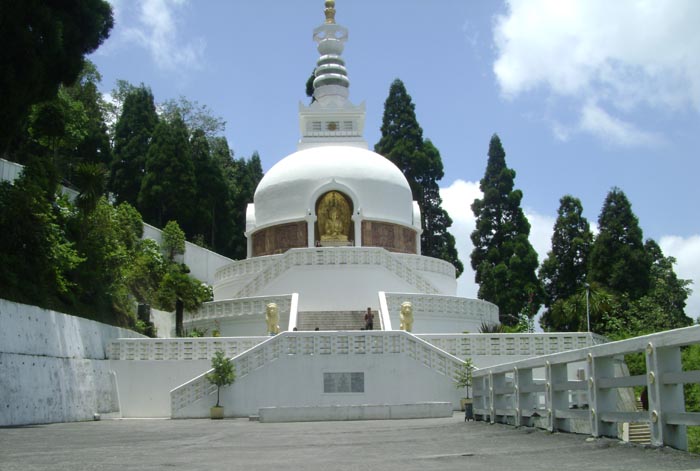Japanese Peace Pagoda

Detail of Japanese Peace Pagoda (Darjeeling, West Bengal) History & Architecture
The Japanese Peace Pagoda or simply the Peace Pagoda is one of the most iconic landmarks of Darjeeling. It is supposed to provide a focus for people of all races and creeds to help unite them in their search for world peace. It is located high up in the hill overlooking the entire Darjeeling town and was built under the guidance of Nichidatsu Fiji (1885 - 1985) who was a Buddhist monk from Japan and founder of the Nipponzan Myohoji Buddhist order. The foundation stone of this pagoda was laid on 3rd of November 1972 and it was inaugurated on 1st November 1992. It is today one of the most visited tourist sites of Darjeeling and is visited by people of all faith and religions.
Japanese Peace Pagoda Religious Significance
This pagoda and temple is affiliated to the Nipponzan Myohoji Buddhist order which is a new religious movement that emerged from the Nichiren sect of Japanese Buddhism and was founded by Nichidatsu Fujii in 1917. This order is a fairly small order of about 1500 persons which includes both monastics and lay supporters. They revere the Lotus Sutra as the highest expression of the Buddhist message. It is also a very popular and worldwide peace movement. The monks, nuns and followers of this movement beat hand drums while chanting the Daimoku and walk throughout the world promoting peace and nonviolence. The peace pagoda in Darjeeling is open to people of all religion, caste and creed. Anyone irrespective of their identity and background are welcome over here.
Japanese Peace Pagoda Architectural Significance
This pagoda was designed by M. Ohka and was completed in 36 months. The height of this pagoda is 28.5 metres and the diameter is 23 metres. Close to the temple there is a two stories white building which was built in traditional Japanese style in the year 1972. This building serves as a temple and a prayer hall where devotees are allowed to be a part of the daily prayer service. The peace pagoda which itself is built in a typical pagoda style in a circular shape showcases the four avatars of Lord Buddha. One has to take a flight of steps to reach the pagoda from the main temple. Coloured in white with the statues and carvings coated in gold colour it is a serene symbol of peace and tranquilities. The temple is well planned and is well planned making it truly a marvel in the architectural filed in Darjeeling. Located amid the green cover of the towering pine and green vegetation, the splendid architect Peace Pagoda, spreads the massage of peace and prosperity in the world and among all religion.
Japanese Peace Pagoda Tourism Significance
The peace pagoda in Darjeeling is one of the must visit places for anyone visiting this gorgeous town. It is included in almost all of the sightseeing packages. From the top of the pagoda you get a panoramic view of the entire Darjeeling landscape including the Kanchenjunga range. As you enter the temple complex you will notice a few small houses on the right with prayer flags fluttering in front of them. There is a main temple complex which is open between 4:30 am to 6 am in the morning and 4:30 pm to 6:30 pm in the evening. Anyone who comes between this is welcome to be a part of the religious rituals.
So, if you happen to drop to Darjeeling also nicknamed as "Queen of Hills", don't miss to visit the holy Peace Pagoda a symbol of peace and prosperity.